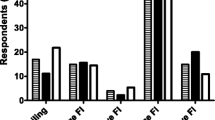Abstract
INTRODUCTION: This report determines the characteristics and health histories that are associated with fecal incontinence in a nursing home population. METHODS: A cross-sectional survey is reported comprised of data from the Health Care Finance Administration's Minimum Data Set submitted by Wisconsin skilled nursing facilities to the Wisconsin Center for Health Statistics' Annual Nursing Home Survey in 1992 and 1993. Demographic characteristics, functional status, and disease history were correlated with the dependent variable, fecal incontinence. RESULTS: In both 1992 and 1993, significant positive associations with fecal incontinence included the following, in order of adjusted odds ratios: urinary incontinence, tube feeding, any loss of activities of daily living, diarrhea, truncal restraints, pressure ulcers, dementia, impaired vision, fecal impaction, constipation, male gender, age, and increasing body mass index. Significant inverse associations were noted for heart disease and depression in one of the years and arthritis in both years. In both years, diabetes was not associated with fecal incontinence. CONCLUSION: Urinary incontinence frequently coexists with fecal incontinence. The treatment of fecal incontinence may depend more on awareness of these significant associations, such as tube feeding, impaction, diarrhea, and loss of activities of daily living, which might exacerbate fecal incontinence, than on the condition of the anal sphincter.
Similar content being viewed by others
References
Nelson RL, Norton N, Cautley E, Furner S. The prevalence of fecal incontinence in Wisconsin households. JAMA 1995;274:559–62.
Leigh RJ, Turnberg LA. Faecal incontinence: the unvoiced symptom. Lancet 1982;1:1349–51.
Profile of Wisconsin Nursing Home Residents, 1992. Madison: Center for Health Statistics, Division of Health, Department of Health and Social Services, 1994.
Morris JN, Hawes C, Fries BE,et al. Designing the National Resident Assessment Instrument for Nursing Homes. Gerontologist 1990;30:293–308.
Crooks VC, Schnelle JF, Ouslander JP, McNees MP. Use of the minimum data set to rate incontinence severity. J Am Geriatr Soc 1995;43:1363–9.
Nursing home characteristics: 1986 inventory of long-term care places. Vital and Health Statistics. Series 14: No. 33. DHHS Publ. (PHS) 8:9–1828.
Denis P, Bercoff E, Bizien MF,et al. Etude de la prevalence de l'incontinence anale chez l'adulte. Gastroenterol Clin Biol 1992;16:344–50.
Schiller LR, Sanat Ana CA, Schmulen AC, Hendler RS, Harford WV, Fordtran JS. Pathogenesis of fecal incontinence in diabetes mellitus. N Engl J Med 1982;307:1666–71.
Drossman DA. What can be done to control incontinence associated with the irritable bowel syndrome? Am J Gastroenterol 1989;84:355–7.
Small KA, Wynne JM. Evaluating the pelvic floor in obstetric patients. Aust N Z J Obstet Gynaecol 1990;30:41–5.
Madoff RD, Williams JG, Caushaj PF. Current concepts: fecal incontinence. N Engl J Med 1992;326:1002–7.
Author information
Authors and Affiliations
About this article
Cite this article
Nelson, R., Furner, S. & Jesudason, V. Fecal incontinence in Wisconsin nursing homes. Dis Colon Rectum 41, 1226–1229 (1998). https://doi.org/10.1007/BF02258218
Issue Date:
DOI: https://doi.org/10.1007/BF02258218




